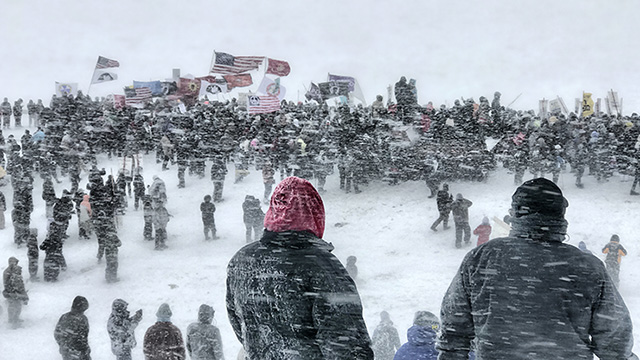
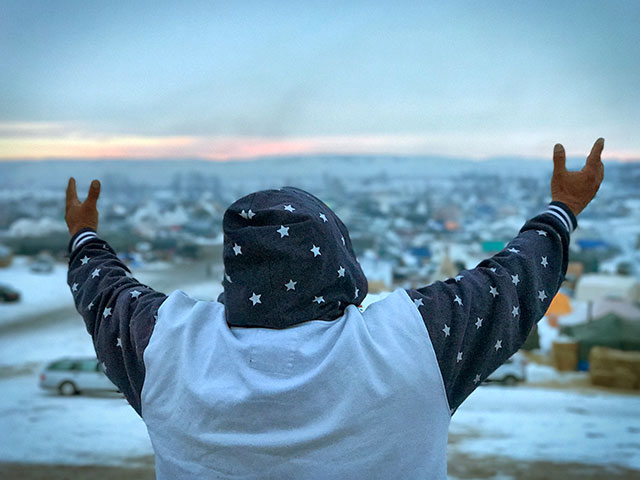 A Water Protector lifts up his voice to the world during Morning Prayer. (Photo: Human Pictures and Other Worlds)
A Water Protector lifts up his voice to the world during Morning Prayer. (Photo: Human Pictures and Other Worlds)
Inauguration Day is here. The wait is over. The administration that is threatening to devastate the future of our world has taken power. Trump, a proud climate denier and adamant supporter of the fossil fuel industry, “intends to cut the bureaucratic red tape put in place by the Obama administration that has prevented our country from diversifying our energy portfolio,” according to his transition team. So where does that leave Standing Rock and the 10-month-long struggle to stop the Dakota Access pipeline (DAPL)?
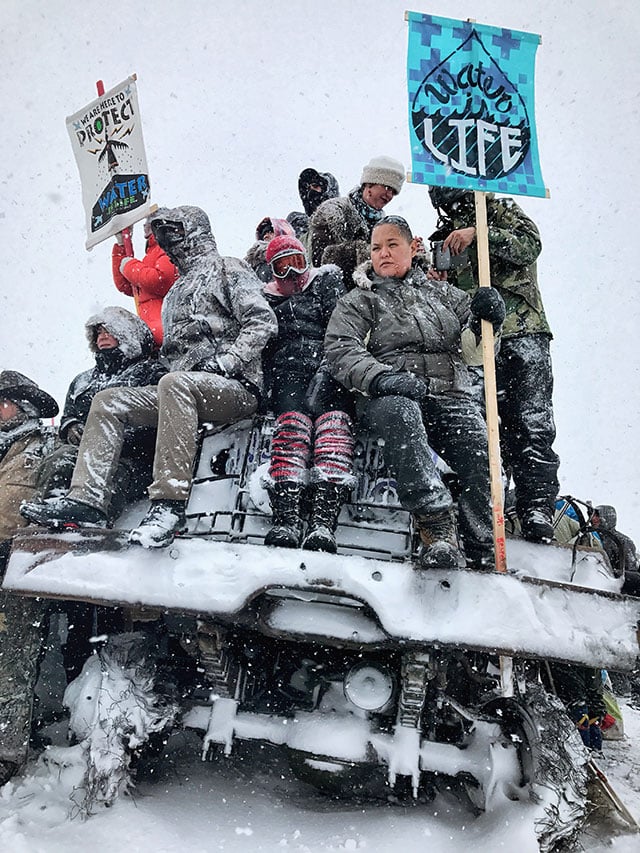 “The mantra, Mni Wiconi (‘water is life’) is the cry that thunders out from a tiny encampment in a remote part of the United States and is being heard around the world,” says Toni Cervantes a relentless Water Protector and photojournalist for the Oceti Sakowin Camp. (Photo: Human Pictures and Other Worlds)
“The mantra, Mni Wiconi (‘water is life’) is the cry that thunders out from a tiny encampment in a remote part of the United States and is being heard around the world,” says Toni Cervantes a relentless Water Protector and photojournalist for the Oceti Sakowin Camp. (Photo: Human Pictures and Other Worlds)
The struggle in Standing Rock reflects the universal tensions and conflicts between the interests of capitalism and the interests of people and Mother Earth. This is a decisive moment on the world stage, and the outcome will set a precedent of what’s to come.
“The water protectors continue to camp there because they are concerned. Dakota Access is still working at the site, even though that is supposed to be on hold…. And the National Guard has [Avenger] missile systems, that are allegedly unarmed … pointed at the camp.” — Angela Bibens
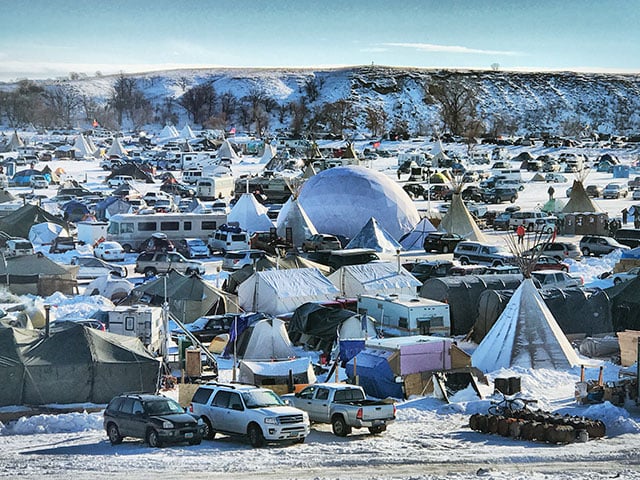 Oceti Sakowin Camp, the main resistance camp, is on a flood plain, so the camp is in the process of relocating before March. (Photo: Human Pictures and Other Worlds)
Oceti Sakowin Camp, the main resistance camp, is on a flood plain, so the camp is in the process of relocating before March. (Photo: Human Pictures and Other Worlds)
 “What this means is the fight is not over,” says Dallas Goldtooth from the Indigenous Environmental Network. (Photo: Human Pictures and Other Worlds)
“What this means is the fight is not over,” says Dallas Goldtooth from the Indigenous Environmental Network. (Photo: Human Pictures and Other Worlds)
On December 4, 2016, the US Army Corps of Engineers (USACE) denied Energy Transfer Partners (ETP) a permit to drill under Lake Oahe on the Missouri River. Despite mainstream media’s portrayal of this denial as a full victory, and despite the fact that many of the 3,000 veterans who had come to stand with Standing Rock for the threatened eviction of the Oceti Sakowin Camp on December 5, 2016, returned home the following day feeling assured by the victory, many Water Protectors regard the day as bittersweet.
Dallas Goldtooth, the Keep it in the Ground organizer for the Indigenous Environmental Network — the organization leading the struggle at Standing Rock and working hand in hand with the Sioux Tribe — affirmed that “the decision by the Obama administration not to grant the final easement was a clear demonstration of effective organizing and mass mobilization and the power of the people and it was not an end-all victory.”
The Sioux Tribe and the Water Protectors were asking for a flat-out denial of the permit and a full Environmental Impact Statement, they got neither. Instead, the USACE said that it wouldn’t issue a permit at that time and that it would only carry out a limited impact statement. After the permit was denied pending further investigation, ETP — the company behind the construction of DAPL — did not leave. In fact, the company’s lights still shine brightly on the camp, their equipment is ready to go and according to Kandi Mossett, the Tribal Campus Climate Challenge Coordinator at the Indigenous Environmental Network, the drill pad site is still a “fortress.”
Mossett said, “There’s an 8-foot trench in front of it, followed by a 15-foot wall that has razor wire that’s all the way around it,” guarded by a heavy police presence paid for by taxpayers. On top of that, the Standing Rock Backwater Bridge on highway 1806 remains closed. This bridge is the same site where on November 20, 2016, officers with Morton County Sherriff’s Department violently assaulted Water Protectors for 10 hours, injuring 300, including Sophia Wilansky who almost lost her arm.
Clashes over the contentious blockage of the bridge continue. On Martin Luther King Day, Water Protectors carried out a direct action at the bridge to manifest their concern that it’s still obstructed. According to Angela Bibens, a lawyer with the Water Protector Legal Collective, Water Protectors were once again shot and tear gassed and 15 were arrested. Bibens added that one of the things that she’s most concerned about “is the report from an eyewitness medic who saw a police officer on a snowmobile run over a Water Protector; [the officer] struck the individual and then proceeded to run them over.” She added that the police took the person away in an ambulance. “We don’t have any information about that person,” she said. “We don’t know where that person was taken, if their family was contacted, what their medical status is, what their legal status is.”
The Water Protector Legal Collective has been working with the Medic and Healer Council to try to track the person down and there’s been “no cooperation from the local hospitals or the Morton County Sheriff’s Department.”
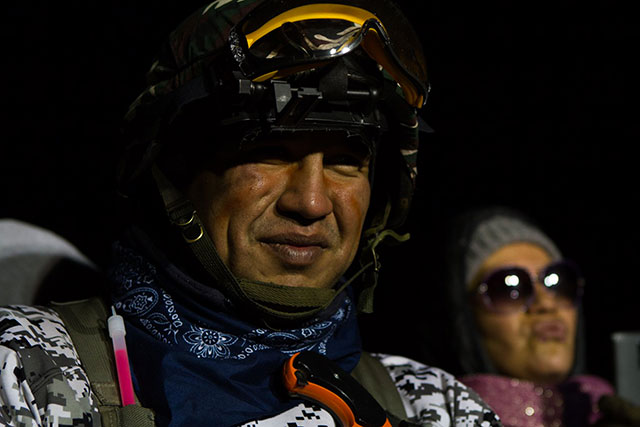 Water Protectors at Backwater Bridge engage in a direct action on MLK Day in 2017. (Photo: Copyright Toni Cervantes Photography 2017)
Water Protectors at Backwater Bridge engage in a direct action on MLK Day in 2017. (Photo: Copyright Toni Cervantes Photography 2017)
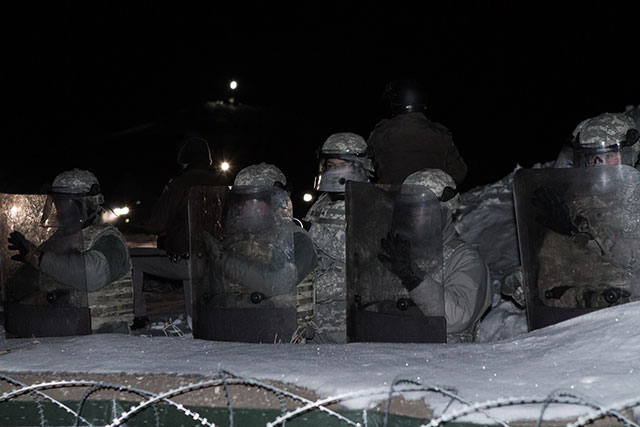 Local authorities during a direct action on MLK Day in 2017. (Photo: Copyright Toni Cervantes Photography 2017)
Local authorities during a direct action on MLK Day in 2017. (Photo: Copyright Toni Cervantes Photography 2017)
The last few days at Standing Rock have been marked by both deplorable events, as well as important advancements. The limited Environmental Impact Statement was just officially started on January 17. This opens the public scoping phase, which invites interested parties to express their views around DAPL crossing Lake Oahe and to identify potential issues, concerns and alternatives to the proposed route.
Prior to the Environmental Impact Statement beginning, there was widespread concern from the Water Protectors that if it didn’t start before Trump came in, that he’d just be able to reverse what Obama did to stall the final parts of pipeline construction. Due to the Environmental Impact Statement just beginning three days ago, there’s not been a lot of time to analyze its impact, but Bibens believes it could afford the tribe and Water Protectors more protection. Bibens said, “I think it’s really good news for the tribe. I am cautiously optimistic that Standing Rock will get the right result.” Nevertheless, all are aware that the US government has a long history steeped in breaking promises that it has made to Indigenous people.
And that is exactly what Kelcy Warren, the CEO of Energy Transfer Partners, is banking on. In an interview with CBS, Warren said once Trump takes office, “It’s 100 percent that the easement [permit] gets granted and the pipeline gets built.”
In a leaked audio recording, ETP’s Chief Operating Officer Matthew Ramsey remarked, “Make no mistake about it, this pipeline is going through. It’s going through exactly where we have planned.”
Trump himself has openly expressed his support for DAPL construction at Standing Rock — but claims it’s not because of his investments there — and has vowed to deal with this issue swiftly once in office. According to Mossett, what this Standing Rock fight did was “call out the ties between industry and government and politics.”
“We know that Trump is going to be antagonistic to our goals to protect mother earth. We know that he’s going to be antagonistic to the goals of protecting our communities and ensuring clean water and safe communities.” — Dallas Goldtooth
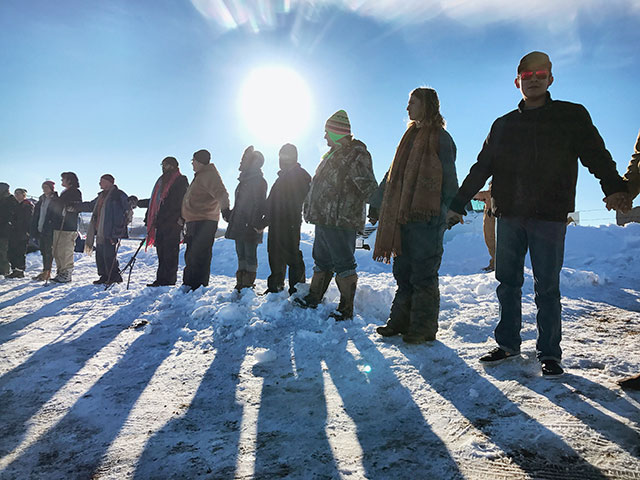 Water Protectors join their hands together in unity and resistance. (Photo: Human Pictures and Other Worlds)
Water Protectors join their hands together in unity and resistance. (Photo: Human Pictures and Other Worlds)
Communities are hoping for the best but preparing for the worst. Mossett points out that Trump’s in-your-face support of the fossil fuel industry allows for an organizing opportunity that may have been missed if Hillary Clinton had been elected. Clinton would likely have pursued less transparent tactics in which she rejected only parts of the industry but trumpeted others. Case in point: her portrayal of natural gas as a cleaner, more environmentally friendly alternative to coal. Opposition to Trump has been a uniting force, bringing together people who have never worked together before, in a way that Mossett believes could fuel a revolution.
According to Thomas Lopez, a member of the International Indigenous Youth Council (IIYC), “In all of these struggles, what we are finding is they’re one [and] the same. The Black struggle is the Native struggle is the gay struggle…. Standing Rock has united us.”
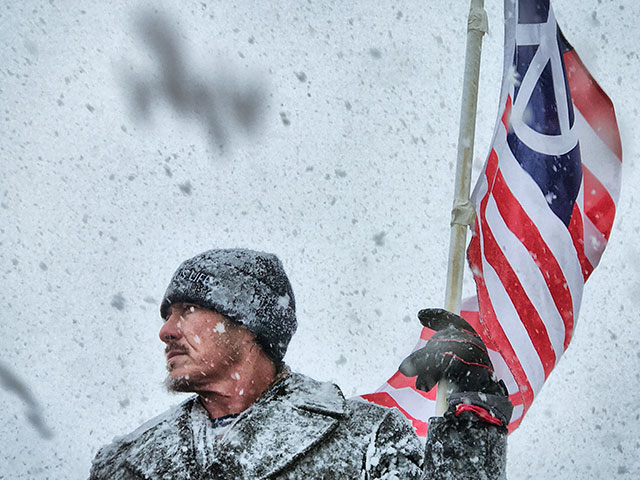 Veterans march with Water Protectors. (Photo: Human Pictures and Other Worlds)
Veterans march with Water Protectors. (Photo: Human Pictures and Other Worlds)
 “As hard as they tried to annihilate us we’re still here. We’re still here and we’re stronger and smarter than ever before,” says Thomas Lopez. (Photo: Human Pictures and Other Worlds)
“As hard as they tried to annihilate us we’re still here. We’re still here and we’re stronger and smarter than ever before,” says Thomas Lopez. (Photo: Human Pictures and Other Worlds)
“This fight against Dakota Access Pipeline has become a national campaign, has become a nationalized fight, an international fight…. We’re focusing on our divestment campaign; we’re focused on increasing the political and social awareness of this pipeline and its impacts.” — Dallas Goldtooth
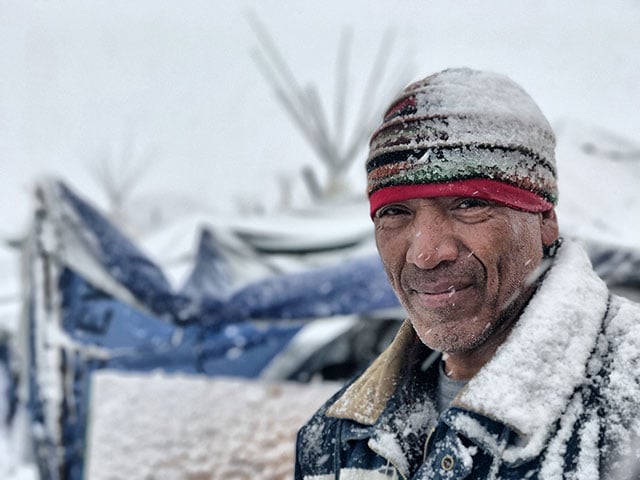 Marco Antonio Iones Gatica is from Inca land in Peru. “Standing Rock is a call that I felt,” he said. “It called the whole world. And when something calls the whole world, it’s because it’s important.” (Photo: Human Pictures and Other Worlds)
Marco Antonio Iones Gatica is from Inca land in Peru. “Standing Rock is a call that I felt,” he said. “It called the whole world. And when something calls the whole world, it’s because it’s important.” (Photo: Human Pictures and Other Worlds)
The divestment campaign “could effectively kill the project in its entirety.” DAPL cuts through four states. The Water Protectors at Standing Rock are not just concerned about what’s happening in their own backyard. “And if this divestment campaign is successful it will protect everybody that’s impacted” by DAPL, declared Mossett.
The divestment campaign is effective largely because it forcefully speaks the language of the investors. “When you speak money and you start to affect their finances — that’s when you start to get a response from them,” said Lopez.
The power of the divestment campaign resounds beyond Standing Rock and has the potential to stop future pipelines. “We’ve already seen this site spark other camps,” Mossett said. “There’s now a camp in Florida against the Sabal Pipeline. There’s a camp in Texas against the Trans-Pecos pipeline. There’s a camp in Louisiana against the Bayou Bridge Pipeline.” It’s worth noting that both the Texas and Louisiana pipelines are backed by ETP. Standing Rock Water Protectors have been sharing organizing strategies with the new camps and sending Water Protectors there.
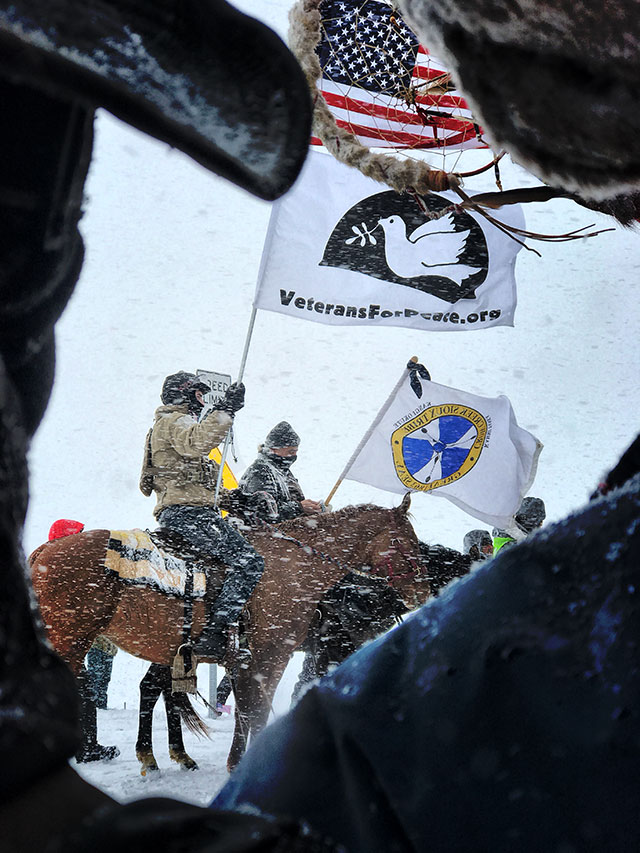

“In order for us to achieve really any kind of movement toward social justice, climate justice, we have to push for systems change…. My greater hope going into this administration is that we see a massive mobilization of resistance against the system.” — Dallas Goldtooth
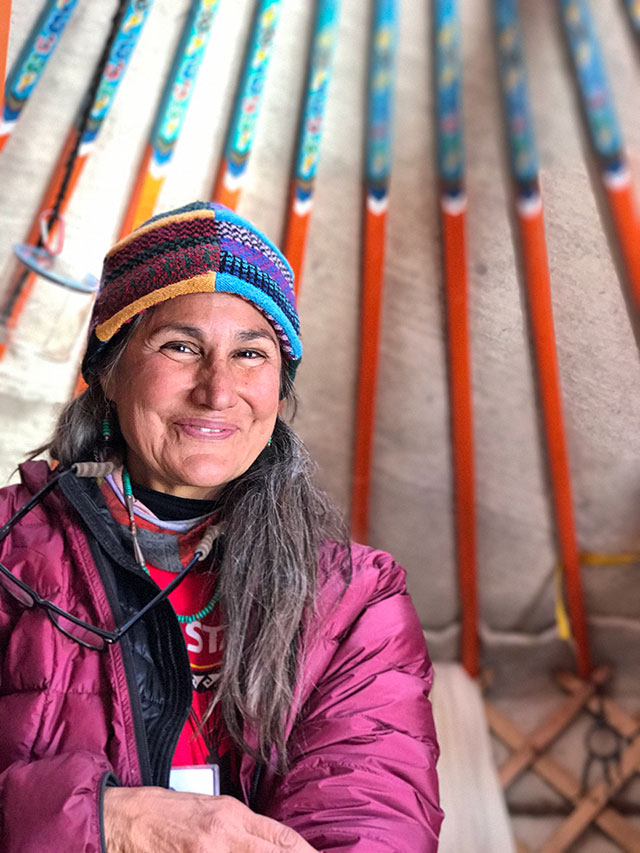 “If we don’t stand up today and draw the line in the sand here, then America, Canada and the world will continue to increase their reliance on fossil fuels; it will not end until the planet has been desecrated, the waters poisoned and the air fouled.” Toni Cervantes (Photo: Human Pictures and Other Worlds)
“If we don’t stand up today and draw the line in the sand here, then America, Canada and the world will continue to increase their reliance on fossil fuels; it will not end until the planet has been desecrated, the waters poisoned and the air fouled.” Toni Cervantes (Photo: Human Pictures and Other Worlds)
Standing Rock has battled its way into the forefront of people’s minds, and now more people than ever are paying attention to pipeline fights. The IIYC, according to Lopez, is working fiercely to show youth that, “it’s cool to care about something and stand up for something.” He goes on to say, “there’s a prophecy that says that the [seventh generation (people currently 29 years old and under)] will actually lead the resistance against the black snake and bring about change amongst the world. And it’s happening.”
Despite frigid temperatures reaching -45 degrees Fahrenheit right now and heartbreaking distance from their families, over 1,000 Water Protectors remain at Standing Rock. Goldtooth proclaims: “We’re ready. What we need to demonstrate as a movement is that we refuse to be regulated to a reactionary position, that we refuse to give ground to this incoming administration based on fear. We are ready to be proactive in our stance. So we see Trump and we’re ready for him and we’re not afraid.”
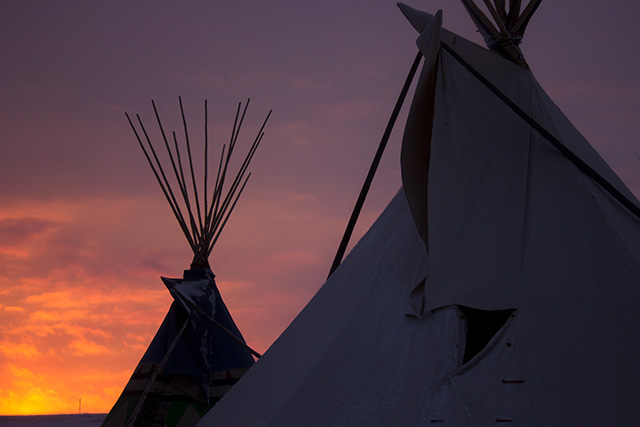 Oceti Sakowin Camp at sunset. (Photo: Melissa Cox)
Oceti Sakowin Camp at sunset. (Photo: Melissa Cox)
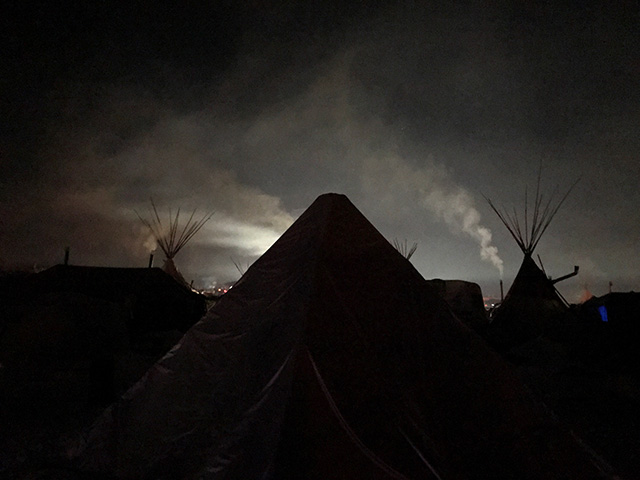 Fires burn at the Oceti Sakowin Camp to warm Water Protectors through the harsh night. (Photo: Human Pictures and Other Worlds)
Fires burn at the Oceti Sakowin Camp to warm Water Protectors through the harsh night. (Photo: Human Pictures and Other Worlds)
For updates and to find out more ways to support the Standing Rock struggle, visit Indigenous Rising, Oceti Sakowin Camp, Sacred Stone Camp, Water Protector Legal Collective, Sacred Stone Legal Defense Fund, and International Indigenous Youth Council, Sioux Tribe.
Join us in defending the truth before it’s too late
The future of independent journalism is uncertain, and the consequences of losing it are too grave to ignore. To ensure Truthout remains safe, strong, and free, we need to raise $43,000 in the next 6 days. Every dollar raised goes directly toward the costs of producing news you can trust.
Please give what you can — because by supporting us with a tax-deductible donation, you’re not just preserving a source of news, you’re helping to safeguard what’s left of our democracy.